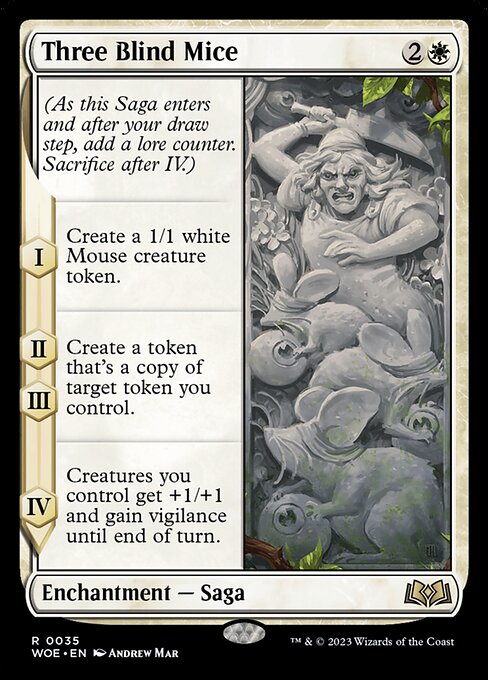
Image courtesy of Scryfall.com
Templating as a Lens into How We Read MTG Cards 🧙♂️
templating in Magic: The Gathering isn’t just a designer's flourish; it’s a practical tool that shapes how we understand a spell the moment it hits the battlefield. When a card uses a clear, sequenced template—think I, II, III, IV for a Saga—the brain can map it into a plan before tapping mana or declaring attackers. This article uses a creature-enchantment from Wilds of Eldraine to illustrate how templating guides strategy, memory, and even the pace of a game 🔥💎.
Meet the spell in question: a Saga with storybook ambitions
From the fairy-tale world of Eldraine, this rare enchantment costs {2}{W} and arrives as a Saga, a class of enchantment whose text unfolds in stages. Sagas are inherently narrative; each chapter counters the last with a new, board-changing effect. The card’s lifecycle is explicit: it enters with a lore counter, you add counters after your draw step, and you sacrifice after the fourth counter. That turn-by-turn arc is designed so players can anticipate, plan, and pivot—without having to parse a wall of text at once 🧙♂️.
Chapter I: a doorway to the mouse-filled battlefield
On the first chapter, I, you get to create a 1/1 white Mouse creature token. The template here is straightforward, almost old-school MTG: “I — Create a 1/1 white Mouse creature token.” The simplicity is intentional. It gives you a tangible foothold: a new creature to influence the board, and a tangible target for future copying. The effect is clean, scalable, and easy to narrate aloud as you plan your turns. In templating terms, this is the entry point that lowers the cognitive barrier for players who are parsing multiple complex boards. And yes, the mouse motif lands with a wink of whimsy in Eldraine’s flavor 🐭🎨.
Chapters II & III: copying the tokens you control
The next two chapters—II and III—up the complexity by instructing you to create a token that’s a copy of a target token you control. The wording is deliberate: “Create a token that’s a copy of target token you control.” The templating here forces you to choose a token, which can be a Mouse or any other creature or token you’ve already created. That choice matters in real games. If you’ve got a buffed or unique token, copying it can duplicate its current power and abilities, multiplying your battlefield impact in a single stroke 🧙♂️⚔️.
From a templating perspective, II and III are a masterclass in modular design: the card doesn’t hard-code a token type. Instead, it leverages your existing board state, inviting you to consider what token to clone for maximum gain. The grammar is compact, but the potential outcomes are expansive, because you’re not locked into a single path—the template adapts to what you’ve already built. This is where good templating shines: it enables creative play without drowning players in edge-case rules talk 🎲.
Chapter IV: a buff that ties the board together
The fourth chapter delivers a broad crescendo: all creatures you control gain +1/+1 and vigilance until end of turn. This is the payoff that makes the earlier copies feel symphonic rather than mechanical. The template is powerful yet predictable, a perfect capstone to a sequence that began with a single 1/1 Mouse and evolved into a board-wide resilience and punch. The word “and” in this line unites the earlier micro-scale cloning with macro-scale board presence, a design choice that rewards planning and timing while still remaining approachable for newer players 💎🔥.
Understanding templating through the lifecycle
What makes templating so influential here is the lifecycle awareness it cultivates. Players learn to count lore counters, anticipate the draw step, and visualize how copying tokens can snowball into a substantial advantage. The text explicitly calls for sacrifice after IV, which creates a natural pacing rhythm: you ride a wave of token generation and copying, then you decide when the board state becomes too rich for the Saga to stay on the battlefield. In practice, templating teaches you to ask: Which token should I copy now? Will buffing all my creatures swing the next combat? Do I risk overextension if I wait a turn? 🧙♂️🎲
Why this matters for understanding MTG today
Templating shapes both new and veteran players’ mental models. When you encounter a card like this Saga, you’re not just reading a spell; you’re internalizing a pattern: “enter-buff-and-build” through a serialized sequence. The structured, chaptered text reduces ambiguity about what happens when and in what order, which is crucial in a game where timing can win or lose matches. For designers, it’s a reminder that readable templates enable deeper strategic exploration without sacrificing flavor or complexity. And for collectors and lore fans, the storytelling arc in the text mirrors Eldraine’s fairy-tale motifs—three little tokens growing into a chorus of mice and a looming climax 🧙♂️🎨.
Art, lore, and the craft of design
Beyond mechanics, the card’s art and theme reinforce the templating experience. Eldraine’s cast of courtly characters, fairy-tale echoes, and knightly dust-ups provide a living backdrop for the arithmetic of tokens and buffs. The “Mouse” token delivers a playful, tactile feel that mirrors the immediacy of the I chapter, while the copy-and-buff crescendo in IV evokes a story arc that your brain can trace as you play. When templating aligns with theme, understanding becomes enjoyable, not just functional 🧙♂️🔥.
“A good template is a compass, not a cage.”
That sentiment sits at the heart of how templating shapes MTG understanding. It invites experimentation while giving players a predictable framework to anchor their decisions, a balance that this Eldraine Saga nails with elegant precision. If you enjoy this kind of design discipline, you’ll notice it mirrors thoughtful usability choices in game design more broadly—where clarity and possibility dance in step 🎯.
Phone Grip Kickstand Click-On HolderMore from our network
- https://crypto-acolytes.xyz/blog/post/efficient-minecraft-xp-farm-designs-you-can-build-today/
- https://blog.digital-vault.xyz/blog/post/how-to-nail-usability-testing-best-practices-explained/
- https://crypto-acolytes.xyz/blog/post/how-pc-esports-prize-pools-work-a-clear-guide/
- https://blog.digital-vault.xyz/blog/post/red-green-dynamics-eye-of-malcator-strategy-guide/
- https://blog.digital-vault.xyz/blog/post/improving-documentation-accessibility-strategies-for-inclusive-tech-docs/